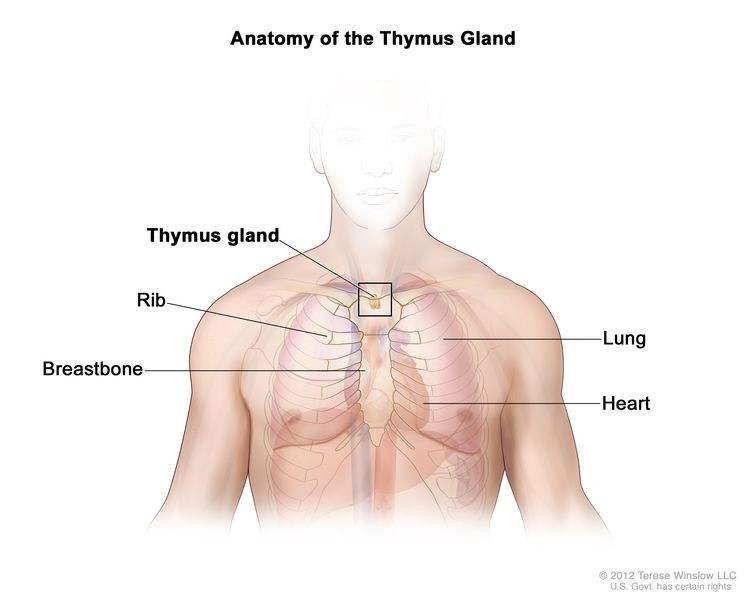The thymus gland is a vital, yet often overlooked, component of our immune system. Understanding Where Is Thymus Found is key to appreciating its role in health and potential diseases like thymoma and thymic carcinoma. This article will explore the thymus gland’s location, its function, and its significance in the context of these conditions.
The thymus is a small organ situated in the upper chest region. To be precise, the thymus is located in the anterior mediastinum, an area within the chest cavity. Think of it as being:
- Above the heart: The thymus sits superior to the heart, nestled in the chest.
- Underneath the breastbone (sternum): It’s positioned right behind your sternum, the long flat bone in the middle of your chest.
- Between the lungs: The thymus resides in the space between your lungs, in the front part of your chest cavity.
This location in the upper chest is crucial for its early role in the development of the immune system, particularly in childhood.
 Anatomy of the thymus gland; drawing shows the thymus gland in the upper chest under the breastbone. Also shown are the ribs, lungs, and heart.
Anatomy of the thymus gland; drawing shows the thymus gland in the upper chest under the breastbone. Also shown are the ribs, lungs, and heart.
Anatomical illustration depicting the thymus gland’s location in the upper chest, positioned beneath the sternum and above the heart, within the ribcage and lung area, highlighting its crucial position in the chest cavity.
The Thymus Gland: More Than Just Location
While knowing “where is thymus found” is fundamental, understanding its function is equally important. The thymus is a specialized organ of the immune system. It is where T-lymphocytes, a type of white blood cell critical for adaptive immunity, mature. You can think of the thymus as a training school for these immune cells.
Here’s a breakdown of the thymus gland’s key functions:
- T-cell Maturation: The primary role of the thymus is to facilitate the maturation of T-cells. These cells are born in the bone marrow but migrate to the thymus to develop and learn to distinguish between the body’s own cells and foreign invaders like bacteria and viruses.
- Immune System Development: The thymus is most active during childhood and adolescence. It plays a vital role in establishing a robust and well-functioning immune system early in life.
- Production of Lymphocytes: The thymus produces lymphocytes, specifically T-lymphocytes, which are essential for fighting infections and diseases.
- Part of the Lymphatic System: As part of the lymphatic system, the thymus contributes to the body’s overall defense mechanisms against pathogens.
Thymoma and Thymic Carcinoma: When Thymus Cells Become Cancerous
Thymoma and thymic carcinoma are rare cancers that originate in the epithelial cells of the thymus. These tumors are also known as thymic epithelial tumors (TETs). Because these cancers develop in the thymus gland itself, understanding where is thymus found helps in understanding where these tumors are located.
While both thymoma and thymic carcinoma arise in the same type of cells, they differ significantly:
- Thymoma: These tumors are generally slow-growing and the cancer cells closely resemble normal thymus cells. Thymomas are less likely to spread beyond the thymus.
- Thymic Carcinoma: These are more aggressive cancers. The cancer cells look less like normal thymus cells, grow faster, and have a higher propensity to spread to other parts of the body. Thymic carcinoma is also typically more challenging to treat than thymoma.
It’s important to note that other types of cancers, such as lymphoma or germ cell tumors, can occur in the thymus region but are not classified as thymoma or thymic carcinoma.
Symptoms and Diagnosis Related to Thymus Location
Often, individuals with thymoma or thymic carcinoma may not experience noticeable symptoms, especially in the early stages. In some cases, these tumors are discovered incidentally during chest X-rays performed for other reasons. However, as the tumor grows in the chest cavity where the thymus is found, it can lead to certain signs and symptoms:
- Persistent Cough: A cough that doesn’t resolve could be a symptom.
- Shortness of Breath: Tumors in the chest can affect breathing.
- Chest Pain: Discomfort or pain in the chest area.
- Hoarseness: Changes in voice.
- Swelling: Swelling in the face, neck, upper body, or arms can occur due to tumor pressure.
Diagnostic tests to examine the thymus and surrounding area, where the thymus is located, are crucial for diagnosing and staging thymoma and thymic carcinoma.
Prognosis and Treatment Considerations
The prognosis and treatment options for thymoma and thymic carcinoma are influenced by several factors, including:
- Type of Cancer: Whether it is thymoma or the more aggressive thymic carcinoma.
- Stage of Cancer: Whether the cancer has spread beyond the thymus to nearby tissues or distant parts of the body.
- Tumor Resectability: Whether the tumor can be completely removed through surgery.
- Recurrence: Whether the cancer is newly diagnosed or has recurred after previous treatment.
Understanding where is thymus found and its function provides a crucial foundation for comprehending conditions like thymoma and thymic carcinoma. If you experience any of the symptoms mentioned, especially persistent cough or chest pain, it’s essential to consult with a healthcare professional for proper evaluation and diagnosis.

